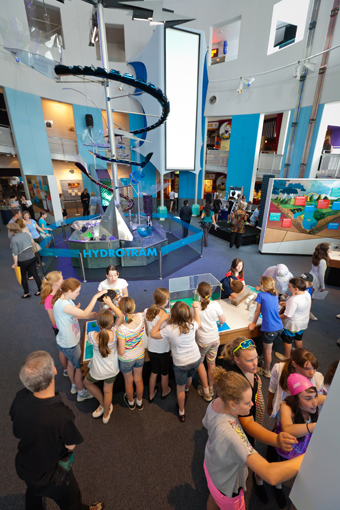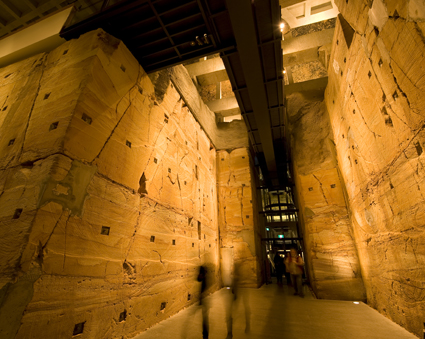The post-museum & the uncertainty principle
Jane Goodall, The post-museum, part 1

Taxidermied possums
© Macleay Museum, 2014, University of Sydney
Taxidermied possums
In November last year, the annual Communicating the Museum (CTM) conference was hosted in Melbourne, headlining the theme “Optimism and New Opportunities.” An international organisation boasting 300 members from institutions in 40 countries, with a mission to share “innovative success stories,” CTM is part of a widespread movement of cultural change sweeping through the museum world. Innovation, reinvention, optimism: the message is relentlessly upbeat, but the enthusiasm is driven by a pulsing anxiety that is all too evident.
A fixation on success stories can betray a fear of failure; operating under the banner of optimism signals a need to banish pessimism; insistent use of the term ‘innovation’ indicates a stressed relationship with heritage and tradition. Since heritage and tradition are core business in the museum world, the culture of institutional reinvention, sometimes badged as the ‘postmuseum’ movement, is inherently fraught. This is the first of a two-part enquiry into the underlying cultural values of the movement, and its perspectives on public culture.
A threatened species
The Macleay Museum on the University of Sydney campus is currently presenting an exhibition titled Stuffed, stitched and studied: Taxidermy in the 19th century. In the essay “Dried and Dessicated—Drawn and Quartered: Natural History Illustration 1700-1877,” curator John Kean focuses on the relationship between biological specimens and images of them from the “lavish natural history monographs of the nineteenth century.”
With its array of bottled reptiles, stuffed mammals, insects pinned in glass cases and information cards inscribed by specialists, the Macleay is an example of the museum itself as a preserved specimen. As an institution, it is a vestige of the past, now a rarity, and certainly a threatened species.
Now hybridised
Major natural history museums in capital cities around the world have evolved into new entities. They have hybridised with other varieties of the science museum to become giant fun parks where you can experience earthquake tremors, tunnel into simulated deep-sea environments and encounter holographic evocations of primordial creatures in ancient landscapes.
This phase of reinvention and change management is underway among cultural institutions of all kinds, but is especially marked in the case of the natural history museum. There may be something about the perversity of keeping large collections of dead things that provokes the human instinct for renovation.
When PT Barnum acquired the American Museum in New York in 1840, he described the existing collection as “stuffed monkeys and gander skins…dead as a herring.” But waste not, want not. With a lick of paint (a touch of gold did wonders for flea-bitten feathers), some inventive storyboarding and the addition of live acts, he transformed this zone of morbidity into the most popular social playground in the city. When it became overcrowded because people refused to leave, he put up a sign saying “To the Egress” so that they would be lured through the exit door in quest of another mysterious creature.

Questacon, The National Science and Technology Centre
The visitor-activated museum
It is worth recalling then that the longer-term history of the museum is a mixed picture. It is not all about conservativism, conservation and the preserves of a social elite. Museums have not always been places where visitors were expected to keep quiet, move carefully and avoid touching the precious objects. Yet in cultural industry forums around the world, the museum of the 21st century is being defined in opposition to just such a stereotype: instead of being a repository for objects, it is an open venue from which exhibitions spill out into open-air locations or migrate to pop-up spaces on the high street. Visitor participation is the main game.
Museums, perhaps more than any other cultural institution, are undergoing an identity crisis. There are dynamic aspects to this, but the determination to create an identity in antithesis to a stereotype is likely to produce another stereotype.
The Macleay, as an example of the traditional museum, is not a stereotype but a prototype. As such, its counterpart is Questacon, the National Science and Technology Centre in Canberra. Both types have their place in a diverse cultural landscape, and both have a history. The Macleay is on a university campus and caters to scholars and specialists, while Questacon is an educational foundation aimed at primary and early secondary school students.
When I visited recently, Questacon was teeming with children in summer holiday mood, most between the ages of two and 12. Early childhood concentration works in irregular bursts. A six-year old will skid across the floor ignoring a sequence of displays, then fix on something for several minutes, often having to be pulled away so as to keep up with the family group.
Engineered visitation
The impulse to mess about with buttons and levers is well catered for, but interactivity is a designed process, in which the chaotic experiments of the child to test the limits of the gadgets are funnelled into a more systematic form of engagement, through which a particular principle can be learned. But young children are very good at confounding attempts to second-guess their reactions.
I watched one small visitor as he came upon an installation that records the voice and plays it back in simultaneous sound and image, showing the wave patterns on a monitor. He quickly got the idea of trying to spike the sound waves with guttural retches. His mother approached, smiling, “Fascinating, isn’t it?….Let’s go now.” “Let’s go now, let’s go now,” he squawked, and as she pulled him away, the machine chimed in, “Let’s go now….let’s go now….”
In the guise of providing the visitor with agency and play, there is actually an attempt to engineer behaviour and determine the learning process. After witnessing this brief victory for the counter-determinist side, I moved on to the next gallery, packed with over 60 multi-media exhibits on the theme of Perception/Deception. Optical illusions, counter-intuitive relations between image and touch and weird textural sensations presented themselves at every turn, each bearing an information placard with the slogan, “Warning! Science Ahead.”
The transmission of fascination
‘Fascinating, isn’t it?’ One of the ingrained determinations of museum curators is that fascination must be transmitted. Whether they try to do this with shelves of bottled fish or a battery of flashing machines, I feel a sense of imposition that makes me want to head for the egress. When Barnum invited the public into his museum, he challenged them to be on the alert about where they might be taken for a ride. Instead of being a target for pedagogy, they were participants in a guessing game about the nature and parameters of reality. Was that actually the missing link? Or the skeleton of a mermaid?

The Void and Lift/Stairwell – MONA, Museum of Art
photo Matt Newton, courtesy MONA Museum of Old and New Art
The Void and Lift/Stairwell – MONA, Museum of Art
MONA: the uncalculated risk
Barnum’s successor in our own times is David Walsh, founder and director of the Museum of Old and New Art (MONA) in Hobart. Walsh, who financed his museum from wins at the horse races and the casino, has a philosophy based on gambling. He interprets the world and his own achievements in it in terms of accident and calculated risk. As a professional gambler he is deeply involved in processes of trying to manipulate the odds, but where his museum is concerned, he was spinning the wheel in a game he didn’t know. The investment was massive, and he stood to lose most of his capital.
Would people come? If they did, how would they respond? Those are the factors on which museum directors around the world are focused, and they want to manipulate the odds in their favour, but Walsh doesn’t seem to have any interest in trying to channel the inclinations of other humans. He has described himself as “introverted to the point of autism in his youth”; evidently objects come before people in his world.
MONA, with its spectacular waterside site built into a rockface, its surround of cafes and markets, its scrolling menu of avant-garde arts events and its weird and wonderful galleries, is in many ways a prime example of what many curators and directors envisage as the museum of the future, but in terms of the binary debate about traditional and contemporary museums, MONA is a paradox. Richard Flanagan describes it as “a mash-up of the lost city of Petra and a late night out in Berlin” (The Monthly, Feb, 2013).
As a teenager, Walsh took to hanging about amid the stuffed Tasmanian tigers and ethnological artefacts in the Tasmanian Museum and Art Gallery, and started his own collections of coins and stamps. When he branched out into more serious adult collections as a means of investing his winnings, he bought Magritte paintings, ancient gold coins, carved doors from a Nigerian palace, central American statuettes, Roman sculptures…well, pretty much anything that a traditional museum would be wanting to acquire. Walsh opened the Moorilla Museum of Antiquities in 1999 in the original Roy Grounds-designed house on the site he’d purchased, holding parties at which his collection could be viewed in formal cabinets.
His subsequent decision to invest in a large-scale, purpose-built public museum was the greatest gamble of his life, and if it remains a financial liability, it has generated so much cultural capital that it is now a major state asset. Visitor numbers of 1.4 million by the end of last year exceeded the population of Tasmania by some 50%.
MONA is an international tourist destination, and in terms of visitor profile, is the envy of major flagship institutions throughout the world, but its cultural orientations are distinctively Tasmanian. Its primary imaginative relationships are with the heritage collections of the Tasmanian Museum and Gallery that inspired it (MONA drew on it for exhibits in the Theatre of the World exhibition, 2012-13) and the Port Arthur Museum.
Aptly, the entry ticket to the Port Arthur site is a playing card. Each visitor is given a one at random and invited to ‘find the convict’ who corresponds with it. As you tour the site, the stories of named convicts are followed through the workplaces to which they were allocated. That was a lottery in which some found a trade or profession that led to a prosperous future as free citizens; some continued through a life of punishment and hard labour; some fell sick and died.
David Walsh’s success with MONA has much to do with his fundamental respect for the role of chance and speculation in human life. When it comes to a competition with pedagogy and designed experience, it’s the uncertainty principle that always wins out in the appeal to human curiosity. How much more intriguing is it to be given a sense of what we don’t know than to be told in ever more animated ways what we do?
RealTime issue #125 Feb-March 2015 pg. 10-11






